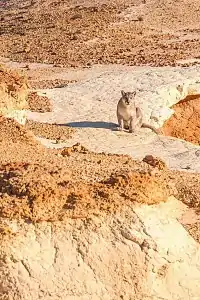South American cougar
The South American cougar (Puma concolor concolor), also known as the Andean mountain lion[2] or puma,[3] is a cougar subspecies occurring in northern and western South America, from Colombia and Venezuela to Peru, Brazil, Argentina and Chile.[4]
| South American cougar | |
|---|---|
 | |
| Cougar at Iguaçu National Park, Brazil | |
| Scientific classification | |
| Kingdom: | Animalia |
| Phylum: | Chordata |
| Class: | Mammalia |
| Order: | Carnivora |
| Suborder: | Feliformia |
| Family: | Felidae |
| Subfamily: | Felinae |
| Genus: | Puma |
| Species: | |
| Subspecies: | P. c. concolor |
| Trinomial name | |
| Puma concolor concolor (Linnaeus, 1771) | |
| Synonyms[1] | |
| |
Taxonomy
Felis concolor was proposed by Carl Linnaeus in 1771 for the cougar type specimen, which originated in French Guiana.[5] Since then, several cougar specimens from South America were described:[4]
- Puma concolor puma proposed by Juan Ignacio Molina in 1782 was a specimen from Chile.[6]
- Puma concolor cabrerae proposed by Reginald Innes Pocock in 1940 was a specimen collected in La Rioja Province, Argentina.[7]
- Puma concolor capricornensis proposed by Edward Alphonso Goldman in 1946 was a specimen from Brazil.[8]
As of 2017, these specimens are considered synonyms of P. c. concolor, the cougar subspecies occurring in South America.[4]
Behavior and ecology

_encounter_near_Lago_Pehoe%252C_just_across_the_lake_from_Salto_Grande_waterfall_-_the_two_cubs_give_us_a_last_curious_look_as_they_crest_the_hill_-_(25186632175).jpg.webp)
The cougar preys on birds, camelids,[3] deer, sloths, rodents, frogs, agoutis and lizards.[9] It sometimes preys on spectacled bear cubs.[10] In San Guillermo National Park, the vicuña[3] is the cougar's main prey species that constitutes about 80% of its diet. It also preys on guanaco, mice and hares.[11] It abandons kills when harassed by Andean condor, which causes them to kill 50% more prey than North American cougars.[12]
Cultural significance
Like the jaguar,[2] the cougar holds historical cultural significance amongst many South American indigenous people.[13] People in the Andes regard the puma as being either a snatcher of souls, or as a helper of people.[2] The cougar's name was used for Incan regions and people. The Chankas, who were enemies of the Incas, had the cougar as their deity.[14]
References
- Wozencraft, W.C. (2005). "Subspecies Puma concolor concolor". In Wilson, D.E.; Reeder, D.M (eds.). Mammal Species of the World: A Taxonomic and Geographic Reference (3rd ed.). Johns Hopkins University Press. pp. 544–545. ISBN 978-0-8018-8221-0. OCLC 62265494.
- Strong, Mary (2012-05-01). "2: Andean Thinking". Art, Nature, and Religion in the Central Andes: Themes and Variations from Prehistory to the Present. Austin, Texas, the USA: The University of Texas Press. pp. 67–91. ISBN 978-0-2927-3571-2.
- Lee, Jane J. (2014-12-06), Andean Pumas Bring National Park in Argentina Back to Life, The National Geographic, retrieved 2020-03-31
- Kitchener, A. C.; Breitenmoser-Würsten, C.; Eizirik, E.; Gentry, A.; Werdelin, L.; Wilting, A.; Yamaguchi, N.; Abramov, A. V.; Christiansen, P.; Driscoll, C.; Duckworth, J. W.; Johnson, W.; Luo, S.-J.; Meijaard, E.; O’Donoghue, P.; Sanderson, J.; Seymour, K.; Bruford, M.; Groves, C.; Hoffmann, M.; Nowell, K.; Timmons, Z.; Tobe, S. (2017). "A revised taxonomy of the Felidae: The final report of the Cat Classification Task Force of the IUCN Cat Specialist Group" (PDF). Cat News (Special Issue 11): 33–34.
- Linnaeus, C. (1771). "Felis concolor". Mantissa plantarum altera. Generum editionis VI et specierum editionis II. Regni animalis appendix. Holmiae: Laurentii Salvii. p. 522.
- Molina G. I. (1782). Saggio sulla storia naturale del Chilli. Bologna: Stamperia di S. Tommaso d’Aquino.
- Pocock R. I. (1940). "Description of a new race of puma (Puma concolor), with a note on an abnormal tooth growth in the genus". Annals and Magazine of Natural History. 11. 6: 307–313. doi:10.1080/03745481.1940.9723683.
- Goldman, E. A. (1946). "Classification of the races of the puma". In Young, S. P.; Goldman, E. A. (eds.). The Puma. Mysterious American cat. Washington D.C.: The American Wildlife Institute. pp. 175–302.
- Nowell, K. & Jackson, P. (1996). "Puma, Puma concolor (Linnaeus, 1771)" (PDF). Wild Cats: Status Survey and Conservation Action Plan. Gland, Switzerland: IUCN/SSC Cat Specialist Group. pp. 131–137. ISBN 2-8317-0045-0.
- Servheen, C.; Herrero, S. & Peyton, B. (1999). Bears: Status Survey and Conservation Action Plan (PDF). Missoula, Montana: IUCN/SSC Bear Specialist Group. ISBN 978-2-8317-0462-3.
- "The Study Subjects: Vicunas and Pumas Wildlife Ecology in San Guillermo National Park". University of Wyoming. Retrieved 2015-01-12.
- Elbroch, L. M.; Wittmer, H. U. (2013). "Nuisance Ecology: Do Scavenging Condors Exact Foraging Costs on Pumas in Patagonia?". PLOS ONE. 8 (1): e53595. Bibcode:2013PLoSO...853595E. doi:10.1371/journal.pone.0053595. PMC 3536754. PMID 23301093.
- Tarmo, K. "On the role of Creation and Origin Myths in the Development of Inca State and Religion". Electronic Journal of Folklore. Kait Realo (translator). Estonian Folklore Institute. Archived from the original on June 30, 2007. Retrieved May 22, 2007.
- Berrin, K. (1997). The Spirit of Ancient Peru: Treasures from the Museo Arqueológico Rafael Larco Herrera. New York: Thames and Hudson.
External links
- "South American Cougar". Free Again. 2005.
- "Puma takes on Guanaco 3 Times Her Weight". YouTube.
- "Meet the Andean puma, one of the largest felines in the Americas".
